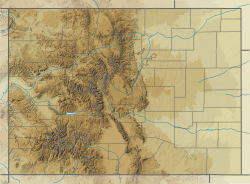| Poison Canyon Formation | |
|---|---|
| Stratigraphic range: late Cretaceous–Paleocene PreꞒ Ꞓ O S D C P T J K Pg N | |
 Rocks in Colorado's Lathrop State Park Rocks in Colorado's Lathrop State Park | |
| Type | Formation |
| Underlies | Cuchara Formation |
| Overlies | Raton Formation |
| Thickness | 650 feet (200 m) |
| Lithology | |
| Primary | Sandstone, mudstone, siltstone |
| Location | |
| Coordinates | 37°31′26″N 105°04′30″W / 37.524°N 105.075°W / 37.524; -105.075 |
| Region | Colorado, New Mexico |
| Country | United States |
| Type section | |
| Named for | Poison Canyon (37°31′26″N 105°04′30″W / 37.524°N 105.075°W / 37.524; -105.075) |
| Named by | R.C. Hills |
  | |
The Poison Canyon Formation is a geologic formation in the Raton Basin of Colorado and New Mexico. The formation was deposited from the late Cretaceous through the Paleocene.
Description
The Poison Canyon Formation consists of thick sandstone beds separated by beds of mudstone and siltstone. It is found throughout most of the Raton Basin. The sandstone is arkosic and coarse-grained to conglomeratic. The mudstone and siltstone beds weather to yellow, are rich in mica, and are not resistant to erosion. The total thickness of the formation is up to 650 feet (200 m).
The formation grades below into the Raton Formation, with the transition often very gradual, up to 150 feet (46 m). In the western part of the Raton Basin, the formation intertongues with and partially replaces the Raton Formation. The two are distinguished by color (the Raton Formation is gray and the Poison Canyon Formation is yellow to orange), by the absence of arkosic sandstone in the Raton Formation, and by the absence of coal from the Poison Canyon Formation. In addition, river channel deposits in the Raton Formation are up to six times wider and five times deeper than river channels in the Poison Canyon Formation, and the channels in the Poison River Formation tend to be isolated and lack any sheet-like amalgamation.
The Poison Canyon Formation underlies the Cuchara Formation in the northern part of the Raton Basin.
The formation derived its sediments from the San Luis uplift to the southwest and the Wet Mountains uplift to the north and northwest. Its age ranges from late Cretaceous (where the formation partially replaces the Raton Formation) to Paleocene.
Fossils
The Poison Canyon Formation contains sparse fossilized plant remains characteristic of the Paleocene.
Economic resources
The formation is a significant freshwater aquifer in the Canon City, Colorado area.
History of investigation
The unit was first named as the "Poison Canyon conglomerates" by R.C. Hills in 1888. Hills later clarified the definition, separating the uppermost beds of his measured section to the Huerfano Formation.
See also
References
- ^ Pillmore, Charles L.; Flores, Romeo M. (1990). "Cretaceous and Paleocene rocks of the Raton Basin, New Mexico and Colorado--Stratigraphic-environmental framework" (PDF). New Mexico Geological Society Field Conference Series. 41: 333–336. Retrieved 14 July 2021.
- Flores, Romeo M. (1987). "Sedimentology of Upper Cretaceous and Tertiary siliciclastics and coals in the Raton Basin, New Mexico and Colorado" (PDF). New Mexico Geological Society Field Conference Series. 38: 258. Retrieved 15 July 2021.
- Zhang, J.; Steel, R.; Ambrose, W.; Fisher, W. (2015). "Decreased Channel Dimensions and Sediment Flux Through the Paleocene Raton-Wilcox Rivers: Implications for Wilcox Shelf Margin". AAPG Annual Convention and Exhibition. Retrieved 15 July 2021.
- Flores, R.M.; Bader, L.R. (1999). "A summary of Tertiary coal resources of the Raton basin, Colorado and New Mexico". U.S. Geological Survey Professional Paper. 1625-A. Chapter SR. doi:10.3133/pp1625A.
- Cullers, Robert L. (June 1995). "The controls on the major- and trace-element evolution of shales, siltstones and sandstones of Ordovician to tertiary age in the Wet Mountains region, Colorado, U.S.A.". Chemical Geology. 123 (1–4): 110. Bibcode:1995ChGeo.123..107C. doi:10.1016/0009-2541(95)00050-V.
- Pillmore, C.L. (1969). "Geology and coal deposits of the Raton coal field, Colfax County, New Mexico". The Mountain Geologist. 6 (3): 125–142. Retrieved 15 July 2021.
- Brown, R.W. (1962). "Paleocene flora of the Rocky Mountains and great Plains". U.S. Geological Survey Professional Paper. Professional Paper. 375. doi:10.3133/pp375. hdl:2027/coo.31924002995300.
- Alther, G.R. (1977). "Geohydrologic setting of the environment near Cotter Mill, Canon City, Colorado". The Mountain Geologist. 14 (2): 69–73. Retrieved 15 July 2021.
- Wolfe, Amy L.; Wilkin, Richard T. (7 February 2017). "Evidence of Sulfate-Dependent Anaerobic Methane Oxidation within an Area Impacted by Coalbed Methane-Related Gas Migration". Environmental Science & Technology. 51 (3): 1901–1909. Bibcode:2017EnST...51.1901W. doi:10.1021/acs.est.6b03709. PMC 7392614. PMID 28029760.
- Hills, R.C. (1890). "Orographic and structural features of Rocky Mountain geology". Colorado Scientific Society Proceedings. 3 (3): 362–458.